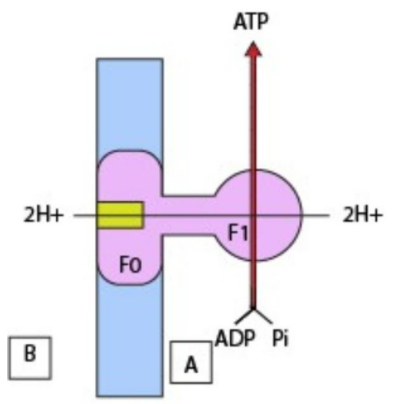
Identify A and B in the given diagram showing ATP synthesis in Oxysomes

A. A = Mitochondrial matrix
B = Outer mitochondrial membrane
B. A = Mitochondrial matrix
B = Inner mitochondrial membrane
C. A = Cell cytoplasm
B = Inner mitochondrial membrane
D. A = Cell cytoplasm
B = Outer mitochondrial membrane

Answer
508.2k+ views
Hint: The exchange of electrons from the intermembranous space, through the inward layer, and back to the network is part of \[ATP\] synthesis. The exchange of electrons from the framework to the intermembranous space causes a large pH difference between the two sides of the membrane.
Complete answer:
A=It is the end product of \[ATP\] synthesis. A= \[ATP\]= It is the end product of \[ATP\] synthesis.
B=The \[F1\] particle is a peripheral membrane protein complex that contains the site for \[ATP\] synthesis from ADP and inorganic phosphate.
C=For the formation of \[ATP\], \[C\text{ }=\text{ }Pi\] is the inorganic phosphatase, which is present along with \[ADP\].
D = The \[2{{H}^{+}}\] ions move through F0 from the inner mitochondrial space to the matrix down the electrochemical proton gradient for every \[ATP\] generated during the \[ATP\] synthesis process.
E = Inner mitochondrial membrane. This is the membrane through which \[2{{H}^{+}}\] ions travel from the mitochondria to the matrix.
Mitochondrial inner membrane the interaction of oxidation and phosphorylation synthesis \[ATP\] in the mitochondria. The increased proton inclination causes an increase in the number of \[{{H}^{+}}\] in the internal mitochondrial space. The protons are pushed back into the lattice by an \[ATP\] synthase complex in the internal mitochondrial layer, which converts \[ADP\] and inorganic phosphate to \[ATP\].
Note:
\[ATP\] synthase is made up of a membrane spanning area known as the \[F0\] subunit and a bumpy projection that stretches out into the framework known as the \[F1\] subunit. The \[ATP\] synthase instrument is not what one would expect. The \[F1\]\[ATP\] synthase subunit can perform its ligase function (producing \[ATP\] from ADP and phosphate) without a proton stream into the lattice; however, the arrival of the \[ATP\] requires a proton stream through the membrane.
Complete answer:
A=It is the end product of \[ATP\] synthesis. A= \[ATP\]= It is the end product of \[ATP\] synthesis.
B=The \[F1\] particle is a peripheral membrane protein complex that contains the site for \[ATP\] synthesis from ADP and inorganic phosphate.
C=For the formation of \[ATP\], \[C\text{ }=\text{ }Pi\] is the inorganic phosphatase, which is present along with \[ADP\].
D = The \[2{{H}^{+}}\] ions move through F0 from the inner mitochondrial space to the matrix down the electrochemical proton gradient for every \[ATP\] generated during the \[ATP\] synthesis process.
E = Inner mitochondrial membrane. This is the membrane through which \[2{{H}^{+}}\] ions travel from the mitochondria to the matrix.
Mitochondrial inner membrane the interaction of oxidation and phosphorylation synthesis \[ATP\] in the mitochondria. The increased proton inclination causes an increase in the number of \[{{H}^{+}}\] in the internal mitochondrial space. The protons are pushed back into the lattice by an \[ATP\] synthase complex in the internal mitochondrial layer, which converts \[ADP\] and inorganic phosphate to \[ATP\].
Note:
\[ATP\] synthase is made up of a membrane spanning area known as the \[F0\] subunit and a bumpy projection that stretches out into the framework known as the \[F1\] subunit. The \[ATP\] synthase instrument is not what one would expect. The \[F1\]\[ATP\] synthase subunit can perform its ligase function (producing \[ATP\] from ADP and phosphate) without a proton stream into the lattice; however, the arrival of the \[ATP\] requires a proton stream through the membrane.
Recently Updated Pages
Master Class 11 Physics: Engaging Questions & Answers for Success

Master Class 11 Chemistry: Engaging Questions & Answers for Success

Why are manures considered better than fertilizers class 11 biology CBSE

Find the coordinates of the midpoint of the line segment class 11 maths CBSE

Distinguish between static friction limiting friction class 11 physics CBSE

The Chairman of the constituent Assembly was A Jawaharlal class 11 social science CBSE

Trending doubts
What is meant by exothermic and endothermic reactions class 11 chemistry CBSE

10 examples of friction in our daily life

One Metric ton is equal to kg A 10000 B 1000 C 100 class 11 physics CBSE

Difference Between Prokaryotic Cells and Eukaryotic Cells

What are Quantum numbers Explain the quantum number class 11 chemistry CBSE

1 Quintal is equal to a 110 kg b 10 kg c 100kg d 1000 class 11 physics CBSE




